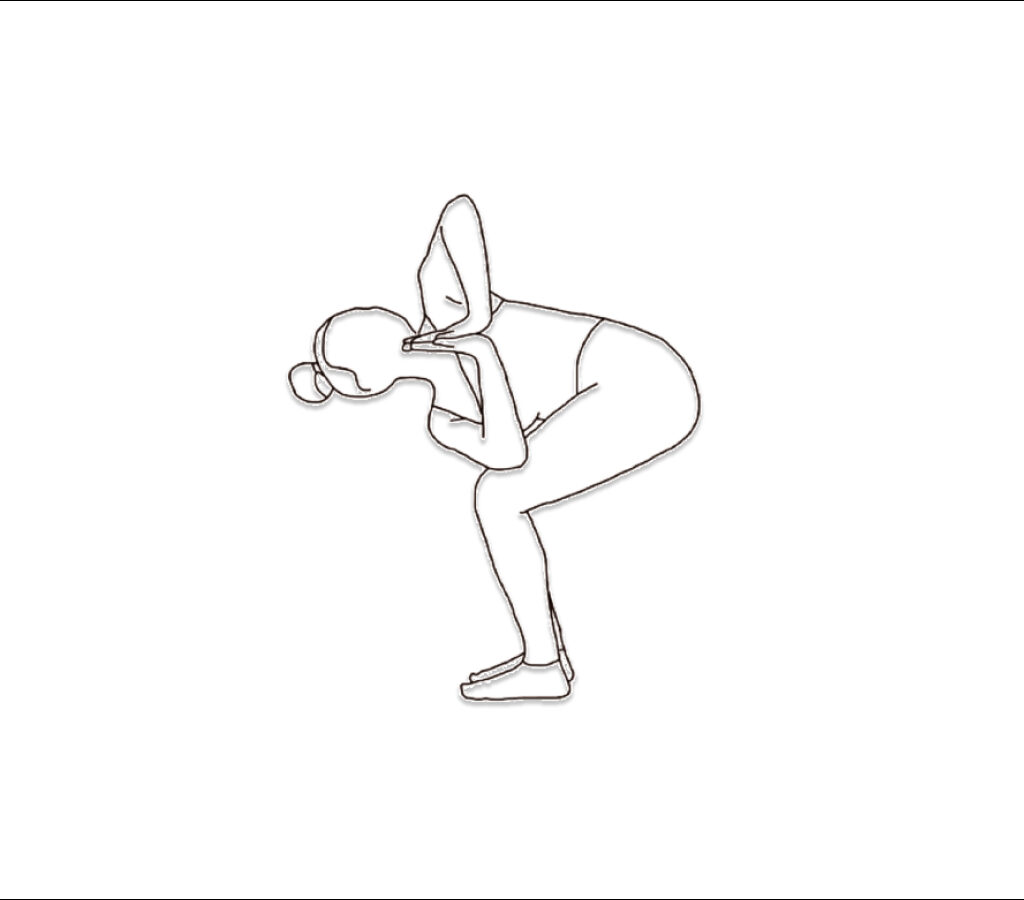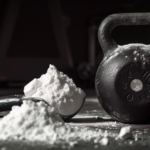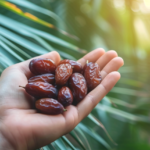Parivrtta Utkatasana, often referred to as the Revolved Chair Pose, is a delightful blend of twisting and balancing that adds a refreshing twist to your yoga routine.
Now, this name might sound exotic, but hear me out. Revolved Chair Pose just means you’ll sit like you’re in a chair, but with a cool twist (literally!). It might sound a bit tricky, but it’s a medium-level pose that can offer amazing benefits, even for beginners with the right modifications.
Here’s why you should give it a try:
Feeling’ sluggish? This pose wakes you up from the inside out! The twist energizes your body and leaves you feeling refreshed and ready to take on the day.
Balance wobble? Not anymore! Revolved Chair Pose strengthens your core muscles, helping you become steadier and more confident on and off the mat.
Body feeling clogged? Think of this pose as a natural detoxifier! The twist massages your internal organs, helping them do their thing and leaving you feeling lighter and healthier.
Intrigued? We thought so! Stick with us, and we’ll teach you all you need to know about Revolved Chair Pose. We’ll break down the steps, offer modifications for different levels, and share handy tips to make sure you practice safely and effectively. So, get ready to unlock your inner yogi and twist your way to a transformed you!
Parivrtta Utkatasana Benefits
In this article, we’ll dive into the wonderful advantages of practicing Parivrtta Utkatasana in simple and easy language, so everyone can understand how it can enhance their well-being.
- Energy Awakening: Feeling sluggish and drained? This dynamic pose is your wake-up call! The twisting action stimulates your internal organs, improving circulation and leaving you feeling refreshed and revitalized. Think of it as a natural energy booster without the caffeine jitters.
- Balance Bliss: Wobbly on your feet? Prone to taking tumbles? Fear not! Parivrtta Utkatasana strengthens your core muscles, the powerhouse of your balance. As you hold the pose, you’ll feel more grounded and stable, both on the mat and in your daily life.
- Detox Delight: Feeling a bit sluggish internally? This pose acts like a natural internal massage! The twist squeezes and releases your internal organs, aiding in detoxification and promoting overall well-being. Imagine flushing out toxins with every twist, leaving you feeling lighter and healthier.
- Digestive Dance: Struggling with digestion? This pose can help get things moving! The twist stimulates your digestive system, encouraging the smooth flow of food and waste. Say goodbye to bloating and hello to a happier gut!
- Flexibility Fiesta: Tight hips and shoulders? This pose can help loosen things up! The twisting action stretches and lengthens your muscles, improving your overall flexibility and range of motion. Feel your body becoming more supple and fluid with each practice.
- Stress Slayer: Feeling overwhelmed and tense? This pose is your stress-busting buddy! The combination of stretching and deep breathing activates your parasympathetic nervous system, promoting relaxation and reducing stress and anxiety. Take a deep breath, twist away your worries, and find your inner calm.
- Mind-Body Magic: Beyond the physical benefits, Parivrtta Utkatasana can also benefit your mind. The focus and coordination required during the pose help cultivate present-moment awareness, while the physical challenge builds your mental resilience. It’s a workout for both body and mind!
Step-by-Step Guide to Parivrtta Utkatasana: Mastering the Revolved Chair Pose
Parivrtta Utkatasana, or the Revolved Chair Pose, is a challenging yet rewarding yoga posture that combines strength, balance, and flexibility. In this step-by-step guide, we’ll break down the pose into simple and easy-to-follow instructions, emphasizing key alignment points and breath awareness to help you master it with confidence.
Step 1: Begin in Tadasana (Mountain Pose)
- Stand tall with your feet hip-width apart, arms relaxed by your sides, and shoulders rolled back.
- Ground down through your feet, lengthen your spine, and engage your core muscles.
- Take a few deep breaths, inhaling through your nose and exhaling through your mouth to center yourself.
Step 2: Chair Pose (Utkatasana)
- Inhale as you bend your knees and lower your hips, as if sitting back into an imaginary chair.
- Keep your knees stacked over your ankles, with your weight evenly distributed between your feet.
- Extend your arms overhead, palms facing each other, or bring your hands to your heart center if that’s more comfortable.
- Lengthen through your spine, keeping your chest lifted and gaze forward. Hold for a few breaths, maintaining steady breathing.
Step 3: Adding the Twist
- Exhale as you bring your hands together in prayer position at your heart.
- Inhale to lengthen your spine once more.
- Exhale, twisting your torso to the right, bringing your left elbow to the outside of your right thigh.
- Press your palms together firmly to help deepen the twist, while keeping your chest open and shoulders relaxed.
- Keep your hips square and weight evenly distributed between both feet.
- Hold the twist for a few breaths, maintaining steady breathing and focusing on lengthening through the spine.
Step 4: Release and Repeat on the Other Side
- Inhale as you return to center, bringing your hands back overhead or to your heart.
- Exhale to release the twist and return to Utkatasana (Chair Pose).
- Take a moment to realign your posture and reconnect with your breath.
- Repeat the twist on the opposite side, bringing your right elbow to the outside of your left thigh.
Key Alignment Points:
- Keep your core engaged throughout to protect your lower back.
- Avoid letting your knees cave inwards; align them with your toes.
- Don’t force the twist; go as far as feels comfortable without straining.
- Maintain a long neck and avoid hunching your shoulders.
- Coordinate your movements with your breath for a mindful experience.
Remember: - This is an intermediate pose; listen to your body and choose modifications if needed. - Beginners can hold onto a chair for balance support initially. - If squatting is challenging, simply step your feet wider and practice the twist from a standing lunge position. - Always prioritize safety and enjoyment over perfect execution.
Common Mistakes and Corrections:
Mistake: Collapsing the Chest
Correction: Engage Your Core and Lift Through the Chest
- Ensure that your core muscles are engaged throughout the pose by drawing your navel towards your spine.
- Lift through the chest and lengthen the spine to avoid collapsing forward.
- Imagine a string pulling your chest towards the ceiling to maintain an open heart.
Mistake: Leaning Too Far Forward or Backward
Correction: Find Balance and Center Your Weight
- Distribute your weight evenly between both feet, keeping them grounded and pressing firmly into the mat.
- Align your knees over your ankles in Chair Pose (Utkatasana) and maintain this alignment as you twist.
- Avoid leaning too far forward or backward by staying centered and maintaining a neutral spine.
Mistake: Overarching or Rounding the Lower Back
Correction: Lengthen the Tailbone and Maintain Neutral Spine
- Draw your tailbone down towards the floor to lengthen the lower back and avoid overarching.
- If you tend to round your lower back, engage your core muscles and lift through the chest to create length and space.
Mistake: Allowing the Knees to Collapse Inward
Correction: Keep the Knees Aligned with the Ankles
- Press the knees gently outward, aligning them with the middle toes to avoid collapsing inward.
- Engage the inner thighs and imagine squeezing a block between your thighs to activate the muscles that support proper knee alignment.
Adjustments for Different Body Types or Limitations:
For Tight Shoulders:
- Use a strap to connect your hands if you’re unable to bring them together in prayer position.
- Focus on opening the chest and shoulders by gently pressing the hands together or against a wall for support.
For Limited Spinal Flexibility:
- Place a block under your hand for support if you can’t reach the opposite thigh.
- Focus on the twist coming from the upper back rather than forcing the movement from the lower back.
For Knee or Hip Pain:
- Use a wider stance in Chair Pose (Utkatasana) to alleviate pressure on the knees and hips.
- Avoid forcing the twist and only go as far as comfortable, listening to your body and backing off if you feel any discomfort.
Safety tips and Contraindications for this potent pose
Safety Tips:
Warm-up Thoroughly: Prepare your body for the twist with gentle movements like neck rolls, shoulder circles, and dynamic stretches. A warm body is a flexible and less prone to injuries.
Know Your Limits: Don’t force the twist! Go as far as feels comfortable without straining. Pushing your limits can lead to muscle pulls or joint pain.
Maintain Core Engagement: A strong core protects your lower back during the twist. Actively engage your core muscles throughout the pose, drawing your belly button towards your spine.
Align Your Knees: Track your kneecaps directly over your ankles, pointing outwards like they’re aiming at opposite walls. Avoid letting your knees cave inwards, as this can strain your joints.
Listen to Your Body: Notice any pain or discomfort and stop the pose immediately. Pain is your body’s way of signaling something is wrong. Rest and seek guidance from a healthcare professional if necessary.
Contraindications:
High Blood Pressure: The twisting action can temporarily increase blood pressure, making this pose potentially risky for individuals with hypertension.
Pregnancy: The twist compresses the abdomen, putting pressure on the uterus. This pose is generally contraindicated during pregnancy unless explicitly advised by a qualified prenatal yoga instructor.
Recent Injuries: Consult your doctor before practicing this pose if you have any recent injuries, especially in your back, knees, or hips.
Vertigo or Dizziness: The twisting action can trigger dizziness in some individuals. If you experience any lightheadedness, come out of the pose slowly and rest.
Seeking Guidance:
If you’re unsure about whether Parivrtta Utkatasana is safe for you, consulting a qualified yoga instructor is essential. They can assess your individual needs, limitations, and any medical conditions you might have. They can also recommend suitable modifications or suggest alternative poses that offer similar benefits without carrying potential risks.
Parivrtta Utkatasana Variations
Variations offer the opportunity to explore this pose deeper, cater to different body types and limitations, and add spice to your yoga practice. Let’s delve into the exciting world of Parivrtta Utkatasana variations!
1. Eagle Arms Twist:
Add an extra challenge by incorporating Eagle Arms into the pose. After reaching your arms out front, bend your right elbow and hook it under your left armpit. Wrap your left arm around your right bicep, palms facing. Maintain the twist and deepen it as you can comfortably.
2. Single Leg Twist:
Take your balance to the next level by lifting one leg off the ground as you twist. Squat with one leg grounded, then extend the other leg straight back, keeping your hips level. Maintain core engagement and twist as usual. Repeat on the other side.
3. Chair Twist with Block:
This variation offers stability and support, allowing you to focus on the twist. Place a block under your sitting bone on the side you’re not twisting towards. Squat down and twist, using the block for support. This allows you to go deeper into the twist without compromising your alignment.
Accessible Options:
1. Standing Revolved Side Angle:
If squatting is challenging, this modification offers a similar twist without the chair pose element. Step your feet a wide distance apart, bend your front knee, and extend your back leg. Twist your torso towards the back leg, reaching your arms outwards for balance.
2. Chair Pose Twist with Wall:
This variation provides stability for those with balance concerns. Stand close to a wall and place your hands on it for support as you squat and twist. The wall helps you maintain proper alignment and prevents wobbling.
3. Half Chair Twist with Chair:
For those with knee limitations, this option offers a comfortable alternative. Sit on a chair with your feet flat on the floor. Twist your torso as you would in Revolved Chair Pose, using the chair back for support if needed.
Parivrtta Utkatasana titles in both English and Sanskrit
Parivrtta Utkatasana (Sanskrit):
- In Sanskrit, “Parivrtta” means “revolved” or “twisted,” while “Utkatasana” translates to “Chair Pose.”
- This title reflects the twisting action of the torso while in the chair-like position, combining strength, balance, and flexibility.
- Practicing Parivrtta Utkatasana in Sanskrit honors the ancient roots of yoga and connects us to its rich tradition and heritage.
Revolved Chair Pose (English):
- In English, Parivrtta Utkatasana is often referred to as the “Revolved Chair Pose.”
- This title describes the fundamental elements of the pose, highlighting both the twisting motion of the torso and the shape of the posture resembling sitting in a chair.
- Using the English title allows practitioners to easily understand and communicate the essence of the pose in a language familiar to them.
How Long Should You Hold Parivrtta Utkatasana (Revolved Chair Pose):
Your Experience: As a beginner, aim for shorter holds of 5-10 breaths per side, gradually increasing as you gain strength and flexibility. Experienced yogis can hold for longer, up to 30-60 seconds per side.
Your Fitness Level: If you’re generally fit and comfortable with bodyweight exercises, you can hold for longer periods. Listen to your body and adjust accordingly.
Your Strength and Flexibility: If squatting deeply or holding the twist is challenging, opt for shorter holds with good alignment. You can also modify the pose to make it more accessible.
Your Energy Level: On energetic days, you might feel comfortable holding longer. Be mindful of fatigue and don’t push yourself to exhaustion.
Your Breath: Your breath is your guide! If you can maintain smooth, rhythmic breaths throughout the hold, you’re likely in a good range. If your breath becomes shallow or labored, shorten the hold.
Benefits of Different Hold Times:
Shorter Holds (5-10 breaths): Great for beginners, warm-ups, or when time is limited. Offer a taste of the benefits without overexertion.
Medium Holds (15-20 breaths): Allow for deeper twists and increased internal stimulation, while still maintaining good form.
Longer Holds (30-60 seconds): Offer an intense challenge for experienced yogis, promoting detoxification and improved balance.
General Guidelines:
- Start with shorter holds and gradually increase as your strength and flexibility improve.
- Always prioritize good alignment over longer hold times.
- Listen to your body and stop if you experience any pain or discomfort.
- If you’re unsure, consult a qualified yoga teacher for personalized guidance.
FAQs
What is the Parsva Utkatasana good for?
Parsva Utkatasana is good for strengthening the legs, core, and improving balance while also stretching the side body.
What is Utkatasana and its benefits?
Utkatasana, or Chair Pose, strengthens the legs, tones the glutes, improves posture, and stimulates the abdominal organs.
What is Parivrtta Utkatasana in English?
Parivrtta Utkatasana in English is commonly known as the Revolved Chair Pose.
What are the benefits of chair pose twist?
The benefits of chair pose twist include spinal flexibility, detoxification, improved digestion, and strengthening of the core muscles.
What are the disadvantages of Utkatasana?
Disadvantages of Utkatasana may include strain on the knees or lower back if performed with improper alignment or for prolonged durations.
What is the another name of Utkatasana?
Another name for Utkatasana is “Awkward Pose” or “Fierce Pose” in English.







